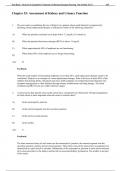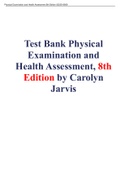Exam (elaborations)
Test Bank - Brunner & Suddarth's Textbook Chapter 53 of Medical-Surgical Nursing 14e
- Institution
- Baptist School Of Nursing
1. The care team is considering the use of dialysis in a patient whose renal function is progressively declining. Renal replacement therapy is indicated in which of the following situations? A) When the patients creatinine level drops below 1.2 mg/dL (110 mmol/L) B) When the patients blood urea ...
[Show more]












